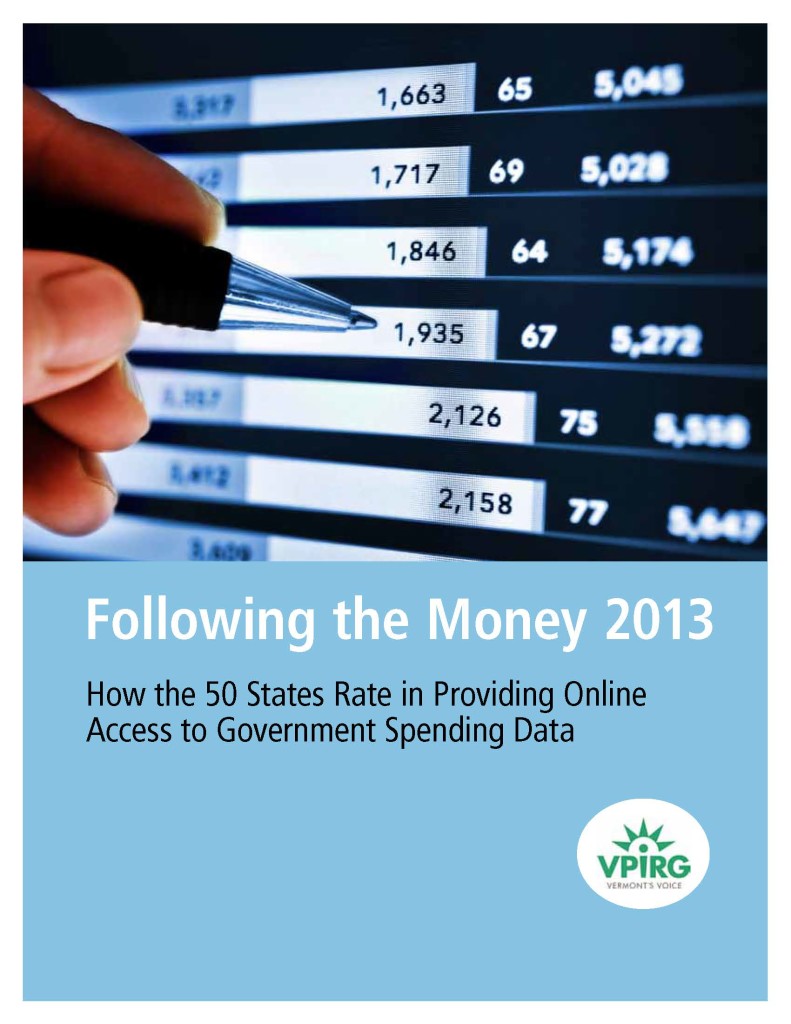NEWS RELEASE
Montpelier, VT – Vermont received a “C+” when it comes to government spending transparency, according to “Following the Money 2013: How the States Rank on Providing Online Access to Government Spending Data,” the fourth annual report of its kind by a federation of public interest research groups that includes the Vermont Public Interest Research Group (VPIRG).
“State governments across the country – including Vermont – have become more transparent about where public money goes, providing citizens with the information they need to hold elected officials and businesses that receive public funds accountable,” said Paul Burns, executive director of VPIRG. “But we still have plenty of room for improvement.”
“This report shows that many states are getting impressive results from making contracts and subsidies more transparent,” said Phineas Baxandall, Senior Analyst for Tax & Budget Policy at U.S. PIRG. “Vermont is not yet among the leading states, but it has shown marked improvement over last year.”
Officials from Vermont and 47 other states provided the researchers with feedback on their initial evaluation of state transparency websites. The leading states with the most comprehensive transparency websites are Texas, Massachusetts, Florida, Illinois, Kentucky, Michigan, and Oklahoma.
Based on an inventory of the content and ease-of-use of states’ transparency websites, “Following the Money 2013” assigns each state a grade of “A” to “F.” The report describes Vermont, which launched a new transparency website called “Spotlight Vermont” in the past year, as an “emerging state” in online spending transparency. The Department of Finance and Management’s new website provides checkbook-level information on contracts, economic development tax credits, grants, and other expenditures in a central location. However, the website does not contain search tools to help users navigate the data, and lacks descriptions of the projected and achieved benefits of economic development subsidies. While there is plenty of room for improvement, the new website represents a great step forward towards spending transparency.
Vermont stands out as one of the top ten most improved states since last year, rising from a “D-” in last year’s report to a “C+” in this year’s report. Vermont is one of the twenty most transparent states when it comes to online spending information.
Since last year’s “Following the Money” report, there has been remarkable progress across the country with new states providing online access to government spending information and several states pioneering new tools to further expand citizens’ access to this data.
One of the most striking findings in this year’s report is that all 50 states now provide at least some checkbook-level detail about individual government expenditures. In 48 states – all except California and Vermont – this information is now searchable. Just three years ago, only 32 states provided checkbook-level information on state spending online, and only 29 states provided that information in searchable form. Thirty-nine state transparency websites now include tax expenditure reports, providing information on government expenditures through tax code deductions, exemptions and credits – up from just eight states three years ago.
“Open information about the public purse is crucial for democratic and effective government,” said Burns. “It’s not possible to ensure that government spending decisions are fair and efficient unless information is publicly accessible.”
The states with the most transparent spending stand out partly because they are comprehensive about the kinds of spending they include, such as data on economic development subsidies, expenditures granted through the tax code, and quasi-public agencies. Vermont is one of at least six states that have launched brand new transparency websites since last year’s report, and most made improvements that are documented in the report. The best state transparency tools are highly searchable, engage citizens, and include detailed information – allowing all the information to be put to good use.
States that have created or improved their online transparency have typically done so with little upfront cost. In fact, top-flight transparency websites can save money for taxpayers, while also restoring public confidence in government and preventing misspending and pay-to-play contracts.
It should be noted that while the state of Vermont has no searchable database for the “Checkbook” information, the checkbook-level data are searchable in a non-government website (www.vttransparency.org). This website is a joint project of the Public Assets Institute and the Ethan Allen Institute. While this website uses data supplied by the state, search features must be a part of a government website in order to receive credit in our report.
“We look forward to the state of Vermont building upon this year’s progress and further improving the breadth and ease-of-access of government spending information through a government transparency portal,” said Burns. “Given our state budget challenges, Vermonters need to be able to follow the money.”
To access the state’s transparency website, click here: http://spotlight.vermont.gov/. To read the report, click here or visit: https://www.vpirg.org/?p=4835
VPIRG is a non-profit, non-partisan advocacy group that has focused on consumer and environmental protection, fair elections and government reform in Vermont for four decades. vpirg.tempurl.host
# # #

